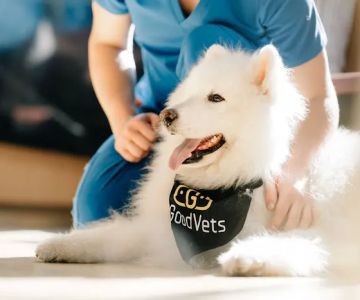How to Handle a Pet’s Jealousy and Strengthen Your Bond
As a pet owner, you know how important it is to maintain a healthy and balanced relationship with your furry friend. However, sometimes things get tricky, especially when jealousy enters the picture. Over the years, I’ve had my share of experiences with pets showing signs of jealousy. Whether it's toward a new family member or even a new pet, understanding how to handle pet jealousy is crucial for a harmonious household. In this post, I’ll walk you through some of the most effective strategies for managing your pet’s jealousy and building a stronger bond with your pet.
1. Understanding Pet Jealousy
Before jumping into how to handle pet jealousy, it’s important to first understand why it happens. I’ve learned that pets, just like humans, can experience a range of emotions. Jealousy often arises when pets perceive a threat to their position or attention. It could be from the arrival of a new pet, a new baby, or even when you give attention to another person or animal. I’ll never forget the first time my dog, Max, displayed jealousy after we adopted a second dog. He became overly protective of me, growled, and even nudged the new dog away when I showed it affection. This behavior is common and can usually be traced back to insecurity or a desire for attention.
1.1 Signs Your Pet is Feeling Jealous
It’s essential to recognize the signs of jealousy in your pet. Some common behaviors I’ve noticed in my pets when they’re feeling jealous include:
- Excessive barking or meowing when attention is directed elsewhere
- Trying to get in between you and another person or pet
- Increased clinginess or attention-seeking behavior
- Aggression or possessiveness over toys or food
- Physical signs of stress such as pacing, drooling, or whining
Recognizing these signs early on can help you intervene before the jealousy turns into more significant behavioral problems.
2. Addressing Jealousy in Pets
Once you’ve identified that your pet is displaying jealousy, the next step is figuring out how to manage it. Over the years, I’ve found several strategies to work effectively for reducing jealousy in pets. Here are the methods I’ve used and recommend based on my experience:
2.1 Equal Attention and Affection
One of the most important things I’ve learned is that pets need reassurance. When Max was jealous of our new dog, I made sure to give him plenty of one-on-one attention. I set aside time each day to play with him, walk him, and give him treats. This helped him feel secure and reminded him that he was still loved and important. It’s essential to strike a balance and not let your pet feel left out. Make sure to pet, play with, and talk to your pet just as much as you would before the jealousy appeared.
2.2 Positive Reinforcement
Whenever I noticed Max acting calmly around the new dog, I rewarded him with treats and praise. Positive reinforcement has been an incredibly effective method for shaping behavior. Whenever your pet behaves well in situations where they would typically feel jealous—such as when another pet receives attention—reward them for their calm demeanor. Over time, they will learn that good things happen when they behave well and that jealousy is not necessary.
2.3 Create Safe Spaces for Your Pets
Sometimes, a jealous pet just needs space. I’ve found that giving pets their own personal areas can reduce the stress of competition. When Max was feeling jealous, I set up a cozy space for him with his favorite bed and toys, so he could retreat there when he felt overwhelmed. This gave him a sense of security and prevented him from acting out due to frustration. If you have multiple pets, it’s a good idea to designate separate areas where they can go to feel safe.
2.4 Training and Behavior Modification
Another helpful step is to invest time in training your pet to reduce jealousy-driven behaviors. Training helps establish boundaries and improves communication between you and your pet. I used basic obedience commands like “sit” and “stay” to teach Max to remain calm in the presence of our new dog. Consistent, calm training can teach your pet how to behave when you are giving attention to someone or something else.
3. How to Manage Jealousy Between Multiple Pets
If you have more than one pet, jealousy can sometimes become more complicated. I’ve had to manage jealousy between my two dogs, and it was a bit tricky at first. Here are some strategies that helped me:
3.1 Ensure Each Pet Feels Secure
When Max and our new dog started having issues, I made sure each one had their own space. This included separate feeding areas and their own beds. I also kept their toys separate to avoid conflicts over possessions. It’s important that your pets don’t feel like they have to compete for your love or attention. With clear boundaries and a little patience, I noticed the jealousy between them slowly dissipated.
3.2 Gradual Introductions and Positive Interactions
Whenever I introduced Max to a new pet, I made sure the introductions were gradual and calm. I always allowed them to sniff each other and get familiar with each other’s presence without forcing them to interact too quickly. Over time, with patience and positive reinforcement, they learned to share space without becoming jealous. It’s also essential to always supervise interactions between pets until they are comfortable with each other.
4. When to Seek Professional Help
Although I’ve had success with these strategies, there were times when the jealousy was more difficult to manage. If you notice that your pet’s jealousy is causing significant behavioral problems such as aggression or destructive behavior, it might be time to seek professional help. A veterinarian or animal behaviorist can help you identify the underlying cause of the jealousy and provide more targeted solutions. I found that consulting a professional helped me navigate tricky situations and ensured the best outcomes for both my pets.











